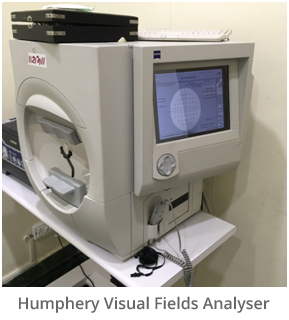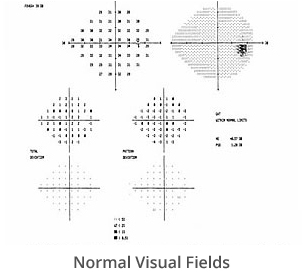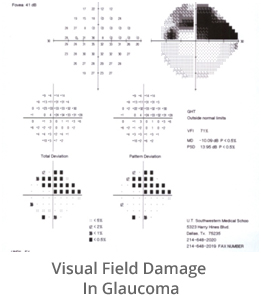Glaucoma Treatment Center Gurgaon
What is glaucoma?
Glaucoma is a group of diseases that cause thinning and damage to the eye’s optic nerve, due to increased pressure inside the eye and can result in vision loss and blindness. The normal eye pressure is below 22 mm of Hg.
What is optic nerve?
The optic nerve (part of retina) is the nerve connecting the eye to the brain. It transmits the images seen by your eye to the brain, and helps the brain to interpret the images.

What are the symptoms of glaucoma?
Most types of glaucoma do not cause any symptoms in the early stages. They cause reduced vision in the very advanced stages of the disease, when >70% of the nerve fibers are already damaged. Occasionally, pain (in head and eye), redness, watering, decreased vision can be noticed.
What are the special investigations performed to diagnose glaucoma?
Tonometry
This test is performed to measure the pressure inside the eye, using an instrument called the tonometer. Various tonometers are available, the gold standard is the contact method using Goldmann’s applanation tonometry.

Gonioscopy
This test is performed to check the drainage angle of the eye, to diagnose different types of glaucoma.

Visual Field Analysis
– To analyze the extent of damage of the optic nerve. This test maps the peripheral vision, which is affected in glaucoma.



Optical Coherence Tomography (OCT)
This test is performed to measure the thickness of the retinal nerve fiber layer (RNFL) surrounding optic nerve. RNFL thinning is present in glaucoma and OCT can diagnose early optic nerve damage even before changes appear in the visual fields.
AS OCT
Anterior segment optical coherence tomography, used to evaluate angles of eye and thus help to rule out types of glaucoma in advance form.
Corneal Pachymetry
To measure the thickness of the cornea (i.e., the transparent front part of the eye), as this can affect the measurement of intraocular pressure. Thicker cornea can give a falsely high IOP reading and thinner cornea can give a falsely low IOP reading. At AEDI, we offer many diagnostic tools to measure the corneal thickness like the Alcon OcuScan, Pentacam.
Glaucoma Treatments
Glaucoma can be treated with medicines (eye drops, pills), laser, traditional glaucoma incisional surgery or a combination of these methods. Glaucoma treatments are designed to decrease elevated intraocular (inside the eye) pressure (IOP), which can damage the optic nerve. Our goal is to prevent vision loss from glaucoma, which is irreversible.
Medical Treatment for Glaucoma
- Ophthalmic Eye Drops for Glaucoma Treatment
- Oral Medications (Pills) for Glaucoma Treatment
These are the most common and early treatment for glaucoma.
Lasers for Glaucoma
NdYag laser.
In angle closure glaucoma, a laser procedure is performed, called YAG laser peripheral iridotomy to create a small hole in the iris (the brown part of the eye) to reduce chances of eye attack and increase space for drainage of eye fluid.
Surgical Treatment for Glaucoma
- Glaucoma Filtration Surgery (Trabeculectomy)
- Glaucoma Drainage Implant Surgery
- Cataract Surgery and Glaucoma
What happens if glaucoma is not treated?
Without treatment, people with glaucoma will slowly lose their peripheral (side) vision initially, people may miss objects to the side and out of the corner of their eye, over time in advance stage, people seem to be looking through a tunnel and latercentral (straight-ahead) vision may decrease until no vision remains.
What can you do?
- Get annual eye check up after the age of 40 years, as glaucoma incidence increases after this age, and can only diagnosed by an eye care physician.
- In cases such as visibility of colored bangles or sudden eye pain with loss of vision consult an eye care physician.
- If you are being treated for glaucoma, be sure to take your glaucoma medicine every day.
- See your eye care professional regularly.
- Get your family members screened for glaucoma, as this is can be a potential risk for this disease.

